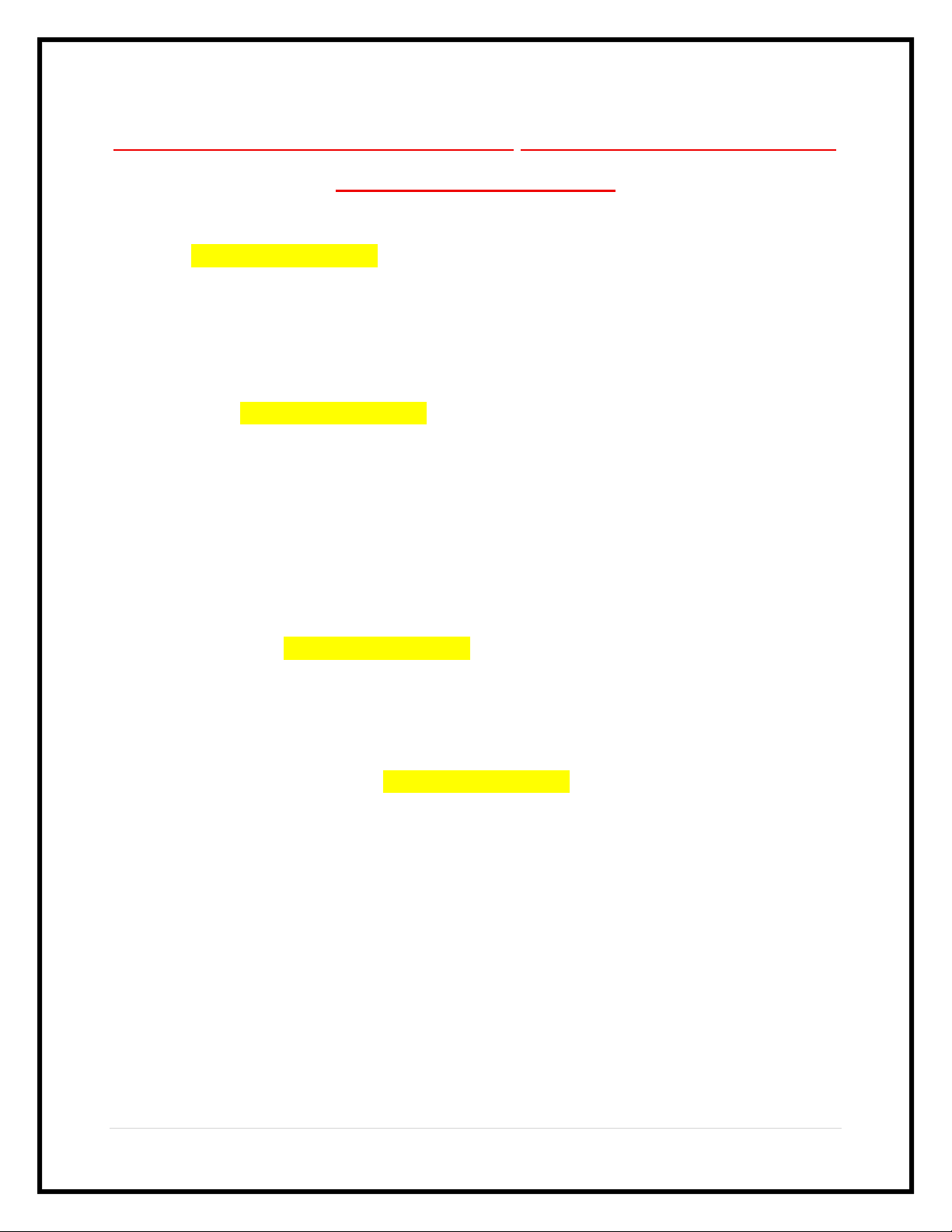
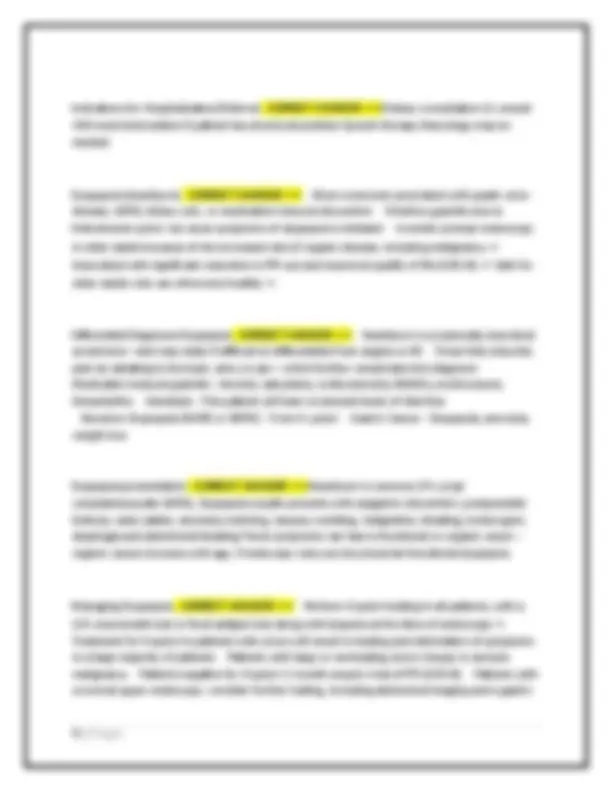
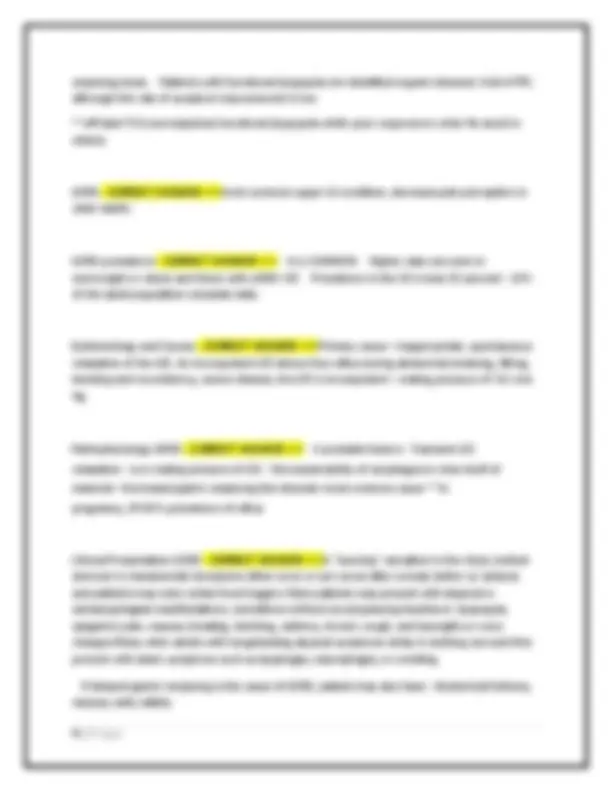
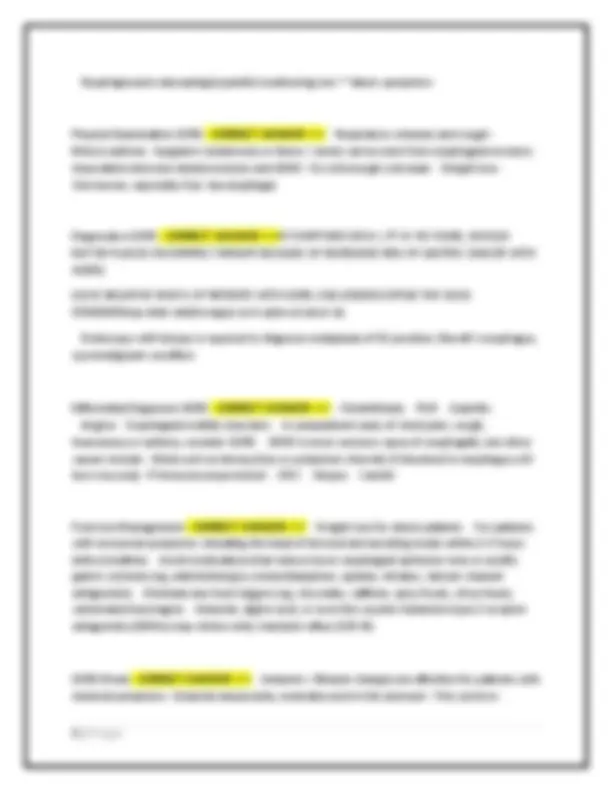
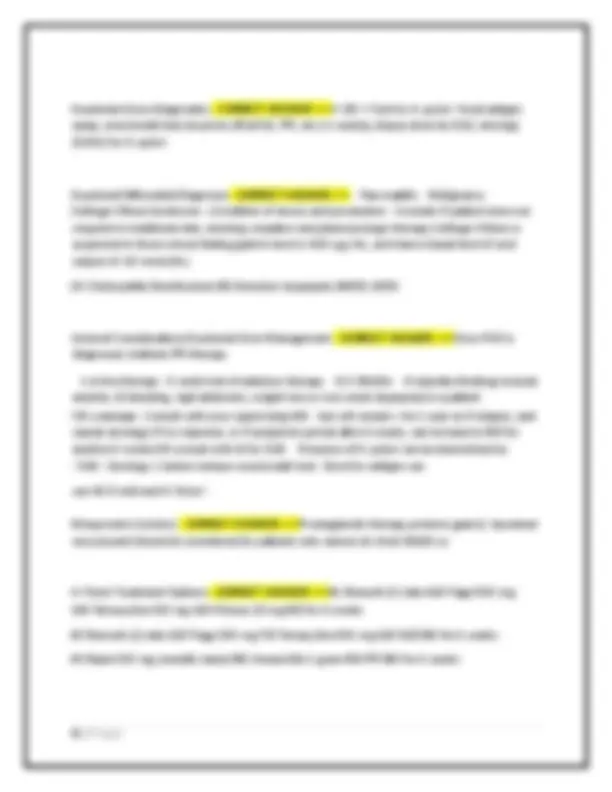
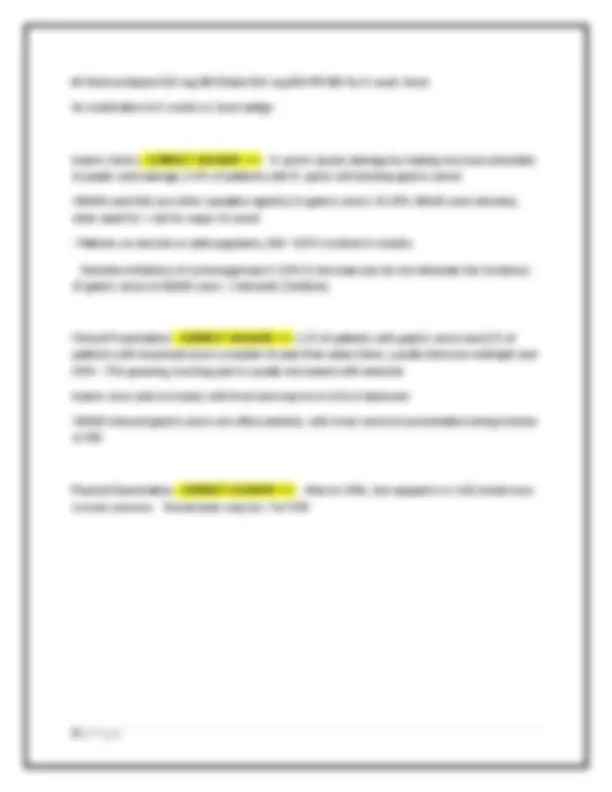
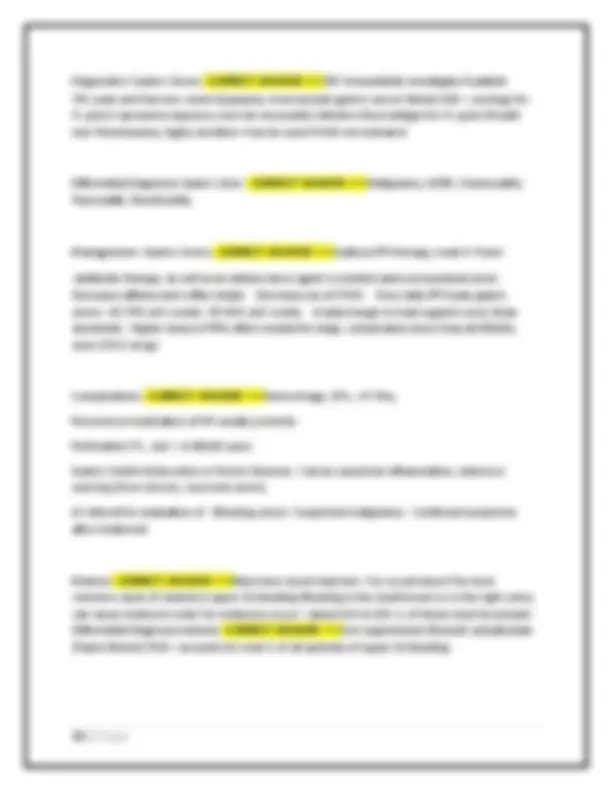
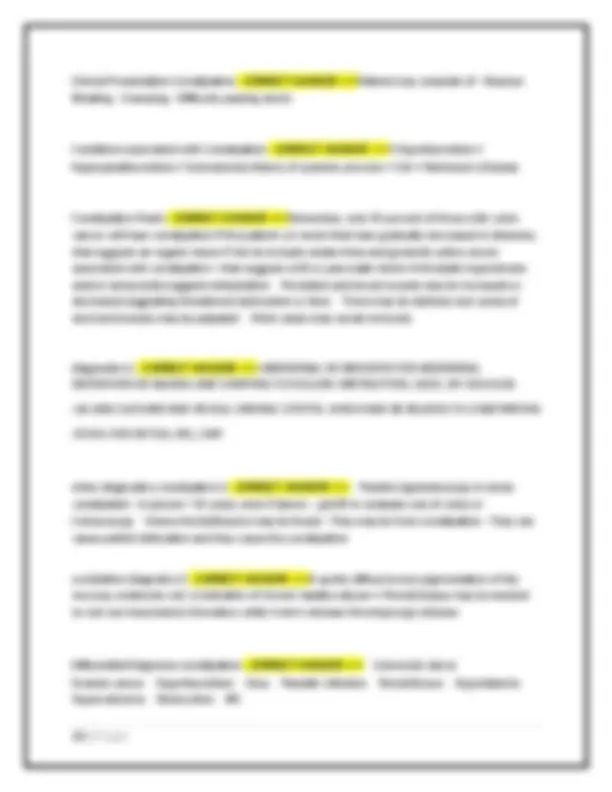
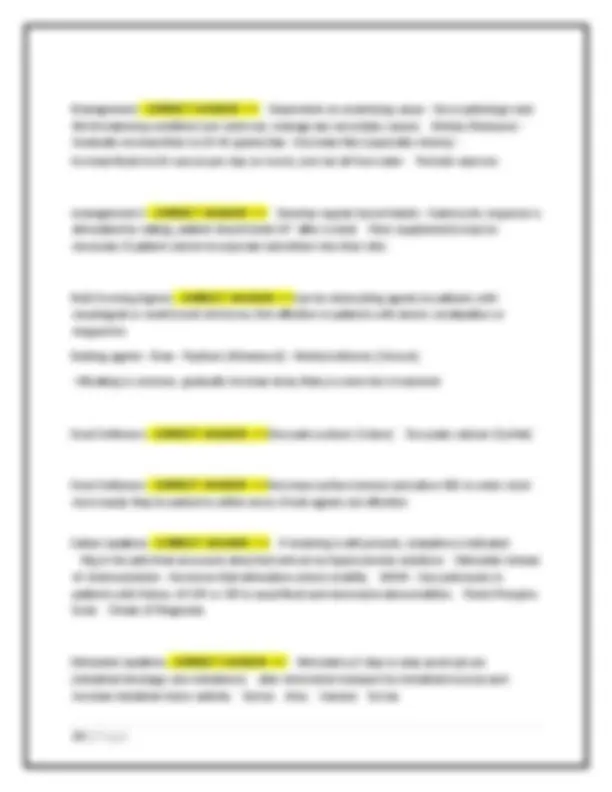
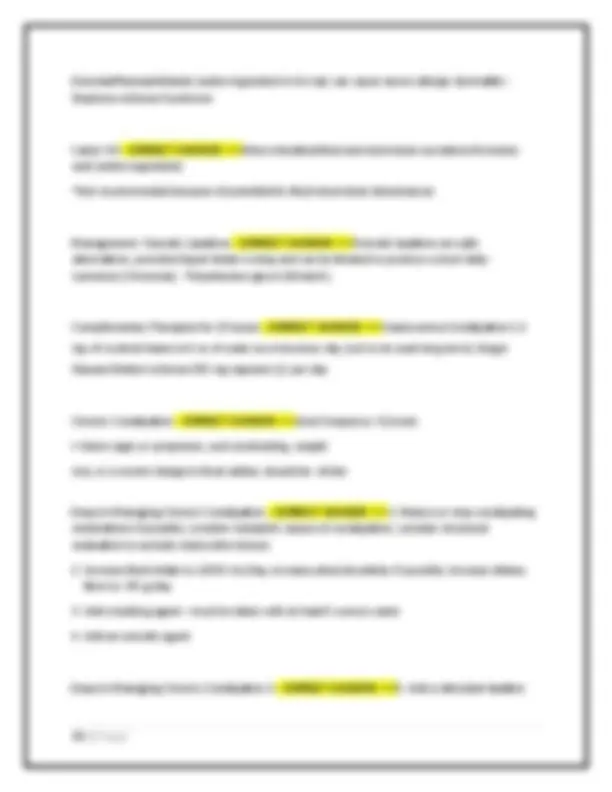
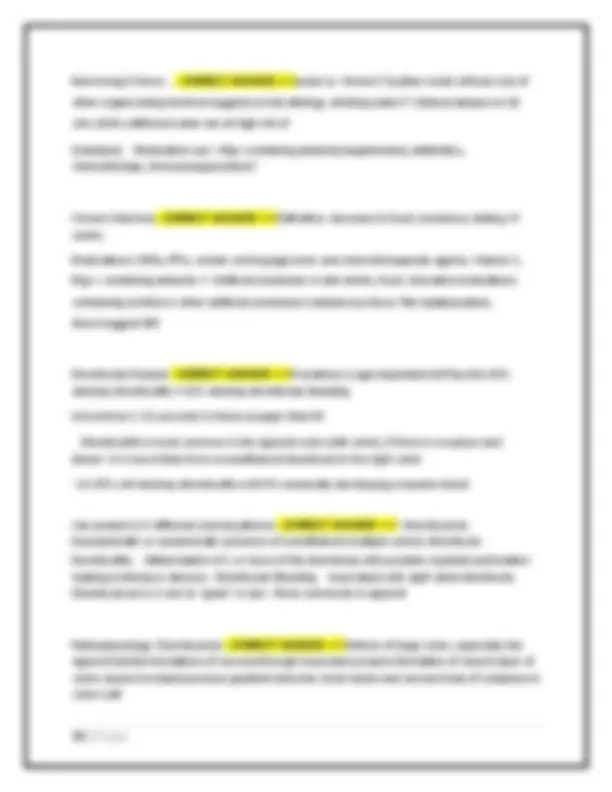
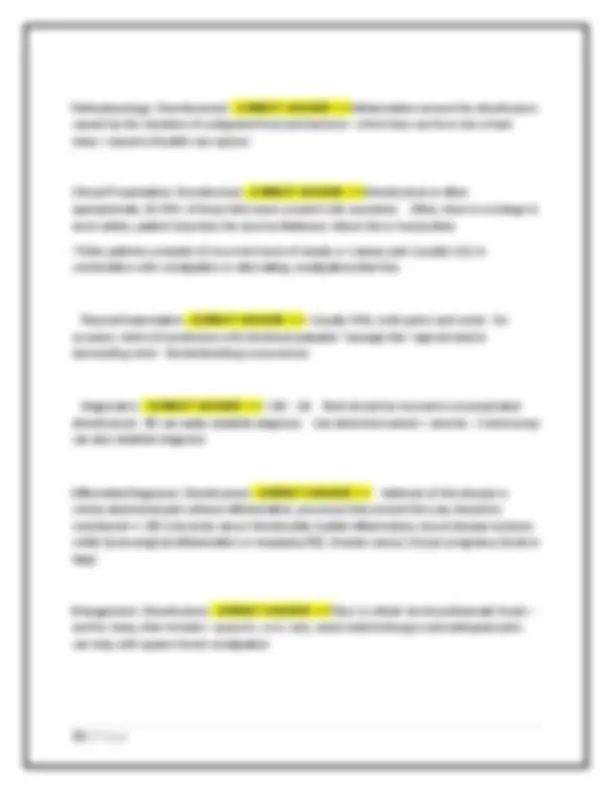
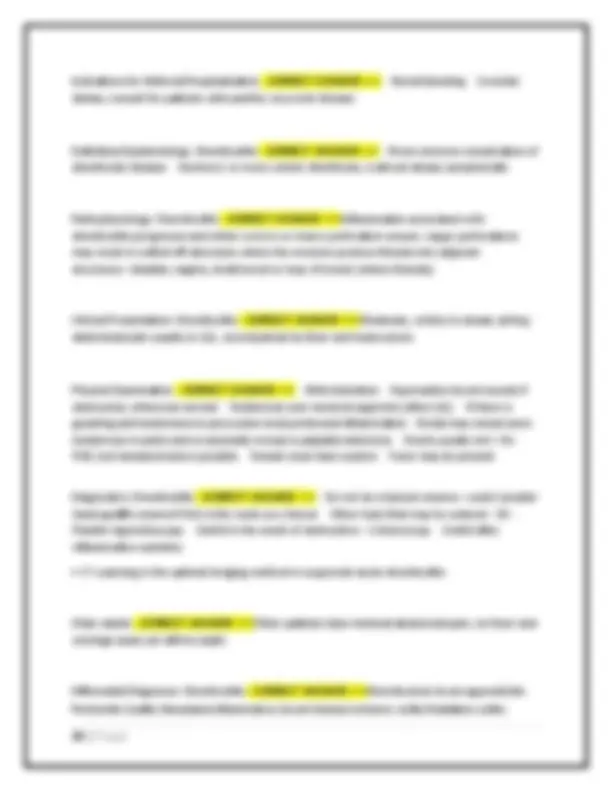
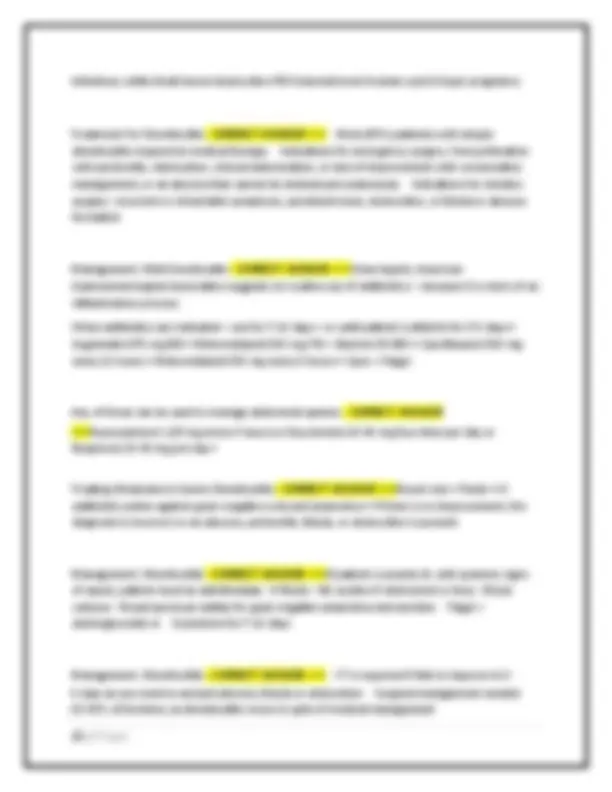
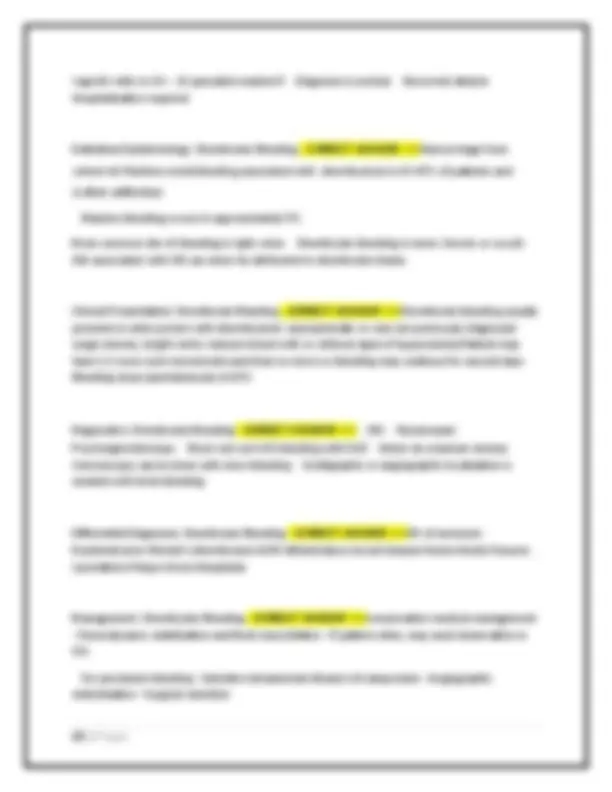
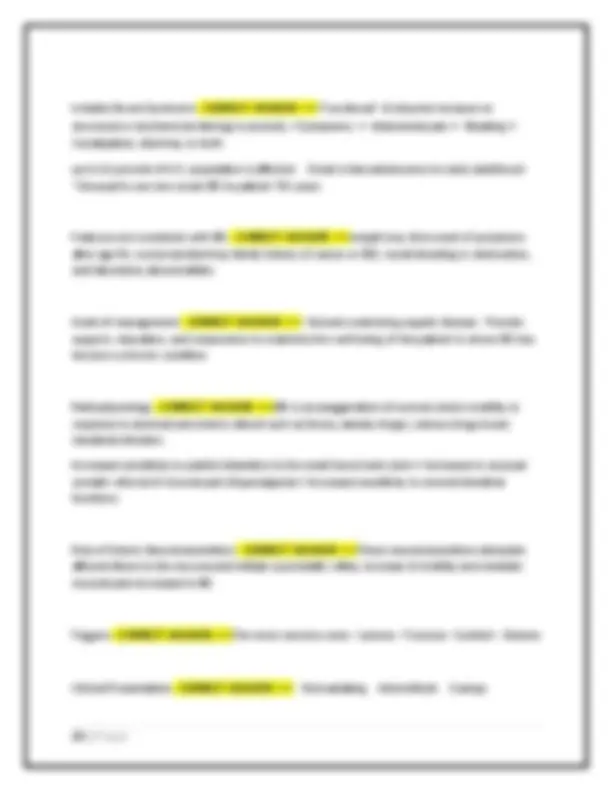
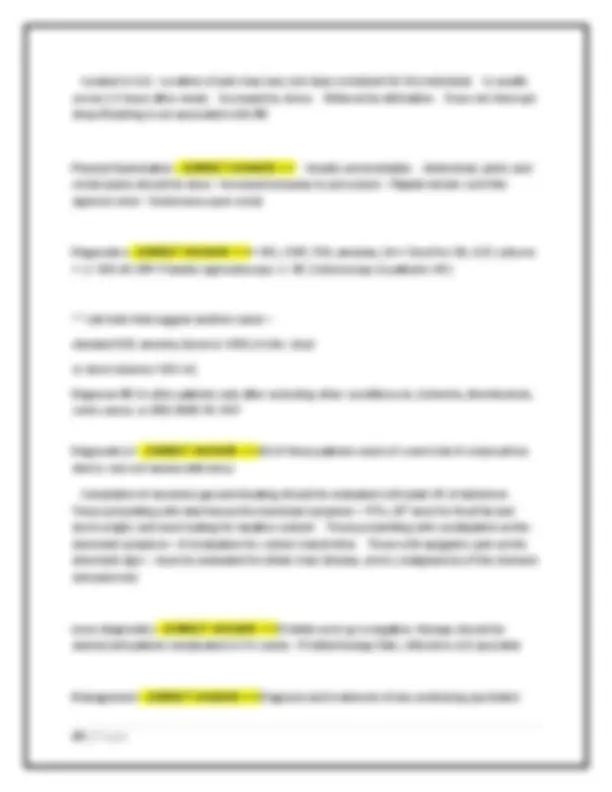
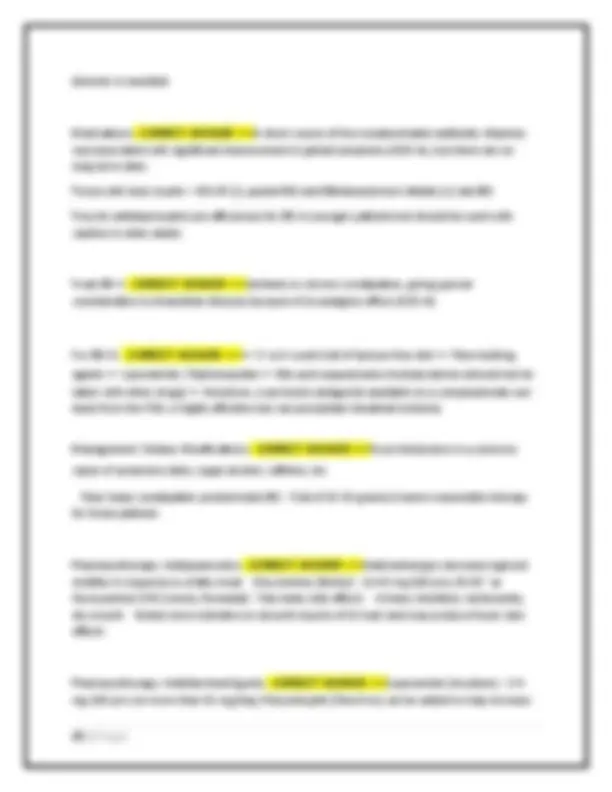
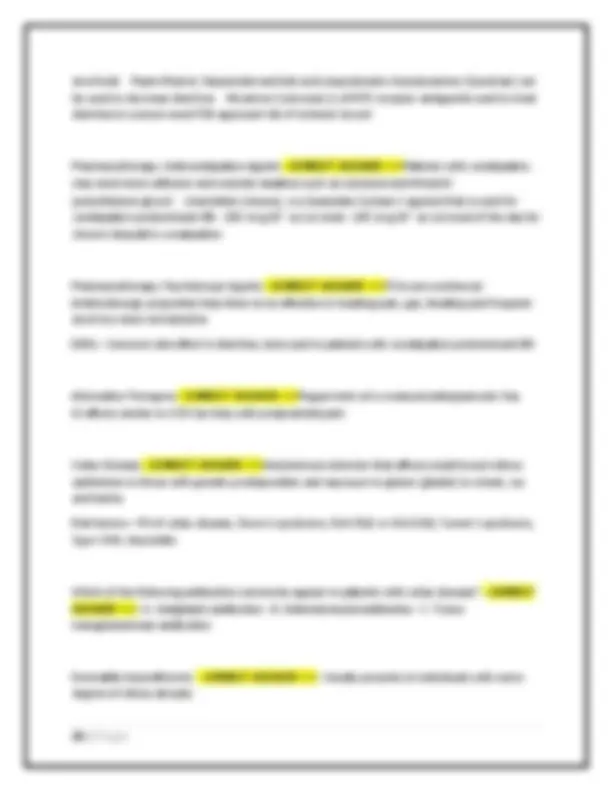
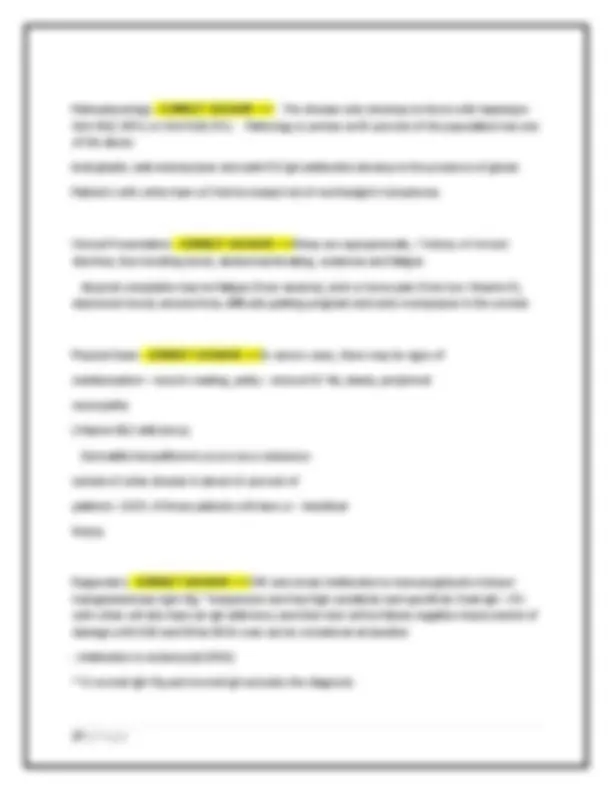
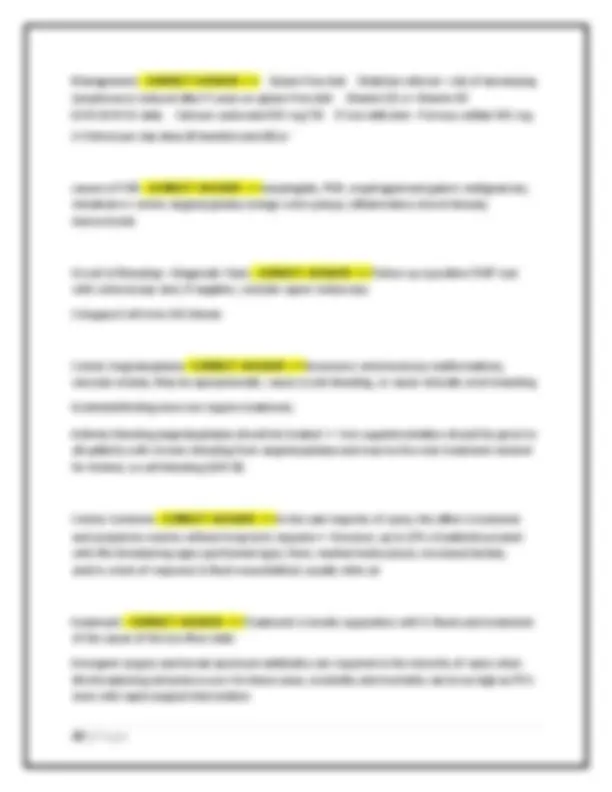
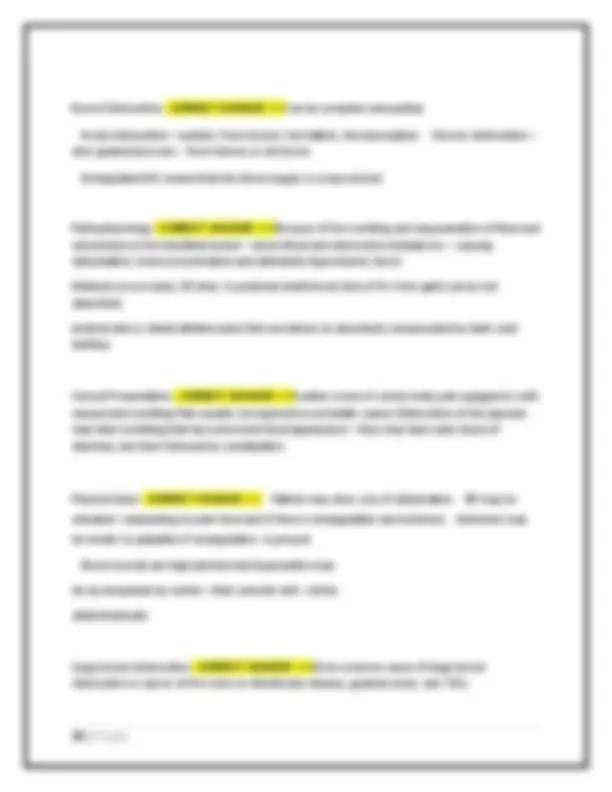
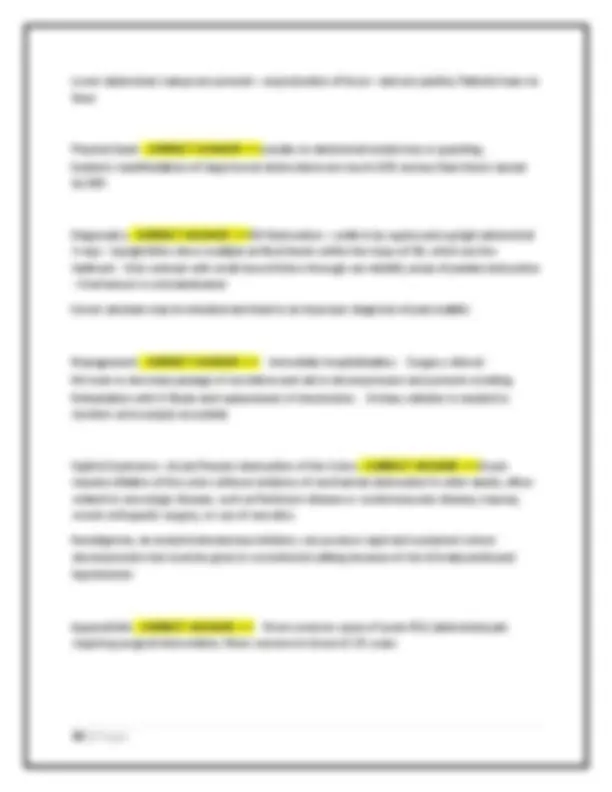
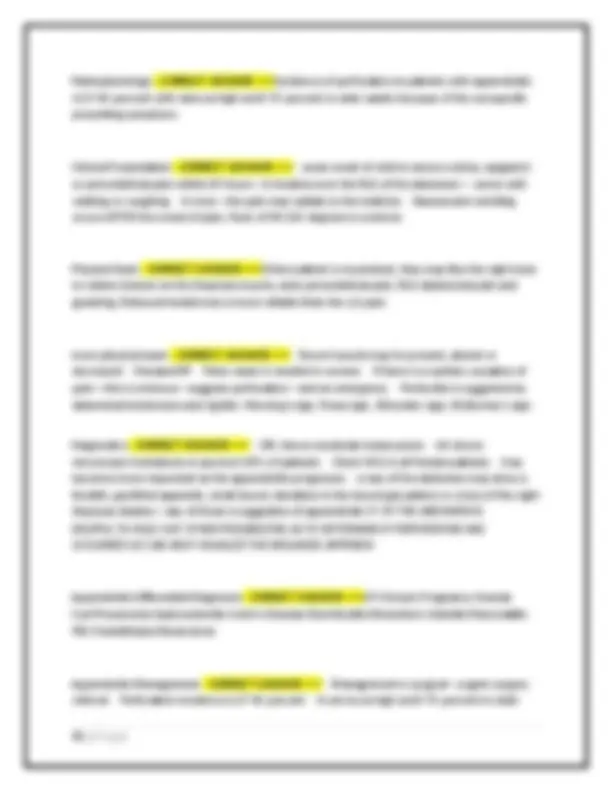
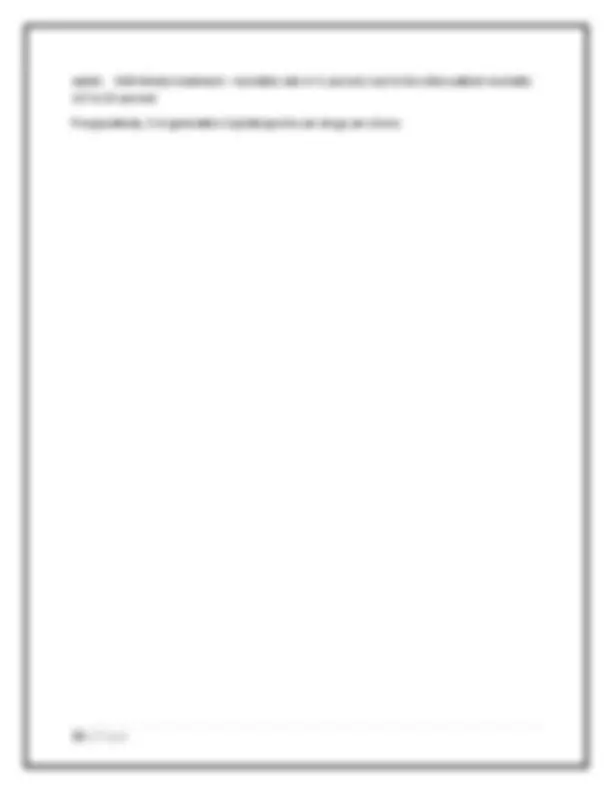


Study with the several resources on Docsity

Earn points by helping other students or get them with a premium plan


Prepare for your exams
Study with the several resources on Docsity

Earn points to download
Earn points by helping other students or get them with a premium plan
Community
Ask the community for help and clear up your study doubts
Discover the best universities in your country according to Docsity users
Free resources
Download our free guides on studying techniques, anxiety management strategies, and thesis advice from Docsity tutors
NURS 5461 GI FINAL EXAM 170 QUESTIONS & ANSWERS (PERFECTLY VERIFIED)
Typology: Exams
1 / 32

This page cannot be seen from the preview
Don't miss anything!

























dysphagia - CORRECT ANSWER >>> Subjective sebsation of difficulty swallowing May be due to physiological or anatomical abnormalities along any portion of the esophagus, including the upper and lower sphincters An alarm symptom that must prompt evaluation and should never be attributed to normal aging without an appropriate evaluation Dysphagia Types - CORRECT ANSWER >>> oropharyngeal (above the esophagus) and esophageal-->most common is achalasia-disorder of esophageal nerves preventing food movement. Structural starts with solids r/o malignancy (adenocarcinoma distal esophagus) infection involves PAINFUL swallowing, viral (CMV usually immunosuppressed) or fungal (candida-inhaled asteroid) Chewing [mastication] - CORRECT ANSWER >>> involves CNV [trigeminal], CNVII [facial], CNIX [glossopharyngeal], and CNXII [hypoglossal], in addition to muscles of jaw, cheeks, tongue and palate Clinical characteristics of Dysphagia - CORRECT ANSWER >>> Problems in the oral phase include - Poor bolus control - Spillage from lips or into pharynx - Dry oral membranes (xerostomia) - Pocketing of oral residue - Difficulty with chewing Pharyngeal dysphagia results from weakness or poor coordination of pharyngeal muscles, which can cause→ - Delayed swallowing
Clinical Presentation - CORRECT ANSWER >>> - Short duration with weight loss suggests malignancy - Abrupt onset associated with neuro changes suggests CVA ¼ - ½ of new stoke patients will have dysphagia gradual progressive onset-PD, ALS, MG medications that can contribute to Dysphagia - CORRECT ANSWER >>> Antidepressants, Antihistamines, Fosamax, NSAIDS, K, Fe, Nitates, BB, CCB diagnostics for dysphagia - CORRECT ANSWER >>> Cineesophagram (video swallow study or videofluoroscpy) Modified barium swallow, endoscopy NOT helpful, alone but may need to r/o other causes DDx dysphagia - CORRECT ANSWER >>> Acute inflammation [infection; bone and mucosal disorders] Stroke syndromes and vascular disorders Myasthenia Gravis Dementias Chemical agents Parkinson's disease Neuromuscular esophageal disorders Multiple Sclerosis Medications Huntington's disease Scleroderma Tuberculosis Muscle anomalies Tetanus Achalasia Syphilis Pharyngoesophageal diverticulum ALS Diffuse spasm NeoplasmsCarcinoma Recurrent laryngeal neuropathies Degenerative disorders Irradiation Guillain-Barre' syndrome Psychopathology Esophageal stenosis Diabetes Feeding phobias Esophageal webs, rings or stricture Cerebral palsy Sensory deficits Management of Dysphagia - CORRECT ANSWER >>> Medication review, particularly focusing on anticholinergic drugs Oropharyngeal dysphagia: Swallowing rehabilitation, dietary modifications such as thickening liquids, or careful hand feeding Achalasia: Surgical or endoscopic myotomy (SOE=A); injection of the lower esophageal sphincter with botulinum toxin may provide months of symptomatic relief in patients who are not surgical candidates Spastic motility disorders: Calcium channel blockers or phosphodiesterase inhibitors may provide relief (SOE=B) Strictures: Endoscopic dilation has a very high success rate, although patients often require ongoing medical treatment of the underlying cause as well Aspiration and Nonoral Feeding in Dysphagia of Functional Origin - Patients with severe aspiration, which is not treatable with dietary or positional modifications, should receive nonoral feedings to prevent aspiration Head positioning, swallowing maneuvers and dietary textural modifications seem to demonstrate clear evidence of benefit in treating functional dysphagia - Refer to speech pathologist for evaluation
emptying study Patients with functional dyspepsia (no identified organic disease): trial of PPI, although the rate of symptom improvement is low **off label TCA (nortriptyline) functional dyspepsia whith poor response to other Rx-avoid in elderly GERD - CORRECT ANSWER >>> most common upper GI condition, decrease pain perception in older adults GERD prevalence - CORRECT ANSWER >>> It is COMMON Higher rates are seen in overweight or obese and those with a BMI >25 Prevalence in the US is near 20 percent - 10% of the adult population complain daily Epidemiology and Causes - CORRECT ANSWER >>> Primary cause—inappropriate, spontaneous relaxation of the LES, An incompetent LES allows free reflux during abdominal straining, lifting, bending and recumbency; severe disease, the LES is incompetent—resting pressure of <10 mm Hg Pathophysiology GERD - CORRECT ANSWER >>> 4 probable factors - Transient LES relaxation - Low resting pressure of LES - Decreased ability of esophagus to clear itself of material - Decreased gastric emptying (fxn disorder most common cause **In pregnancy, 25-58% prevalence of reflux Clinical Presentation GERD - CORRECT ANSWER >>> A "burning" sensation in the chest, behind sternum is characteristic Symptoms often occur or are worse after a meal; better w/ antacid, and patients may note certain food triggers Older patients may present with atypical or extraesophageal manifestations, sometimes without accompanying heartburn: dyspepsia, epigastric pain, nausea, bloating, belching, asthma, chronic cough, and laryngitis or voice changes Many older adults with longstanding atypical symptoms delay in seeking care and first present with alarm symptoms such as dysphagia, odynophagia, or vomiting If delayed gastric emptying is the cause of GERD, patient may also have - Abdominal fullness; nausea; early satiety
Dysphagia and odynophagia (painful swallowing) are **alarm symptoms Physical Examination GERD - CORRECT ANSWER >>> Respiratory wheezes and cough - Mimics asthma Epigastric tenderness or Heme + stools can be seen from esophageal erosions Association between dental erosions and GERD - Do a thorough oral exam Weight loss - Worrisome, especially if pt. has dysphagia Diagnostics GERD - CORRECT ANSWER >>> IF SYMPTOMS NEW I, PT IS >50 YEARS, SHOULD NOT BE PLACED ON EMPIRIC THERAPY BECAUSE OF INCREASED RISK OF GASTRIC CANCER WITH AGING UGI IS NEGATIVE IN 80% OF PATIENTS WITH GERD, EGD (ENDOSCOPY)IS THE GOLD STANDARDesp older adults-vague sx in spite od sever dz. Endoscopy with biopsy is required to diagnose metaplasia of EG junction, Barrett's esophagus, a premalignant condition Differential Diagnoses GERD - CORRECT ANSWER >>> Cholelithiasis PUD Gastritis Angina Esophageal motility disorders In unexplained cases of chest pain, cough, hoarseness or asthma, consider GERD GERD is most common cause of esophagitis, but other causes include - Meds such as tetracycline or potassium chloride [if dissolved in esophagus will burn mucosa] - If immunocompromised CMV Herpes Candid First-Line Management - CORRECT ANSWER >>> Weight loss for obese patients For patients with nocturnal symptoms: elevating the head of the bed and avoiding meals within 2-3 hours before bedtime Avoid medications that reduce lower esophageal sphincter tone or acidify gastric contents (eg, anticholinergics, benzodiazepines, opiates, nitrates, calcium channel antagonists) Eliminate any food triggers (eg, chocolate, caffeine, spicy foods, citrus foods, carbonated beverages) Antacids, alginic acid, or over-the-counter histamine type 2 receptor antagonists (H2RAs) may relieve mild, transient reflux (SOE=B) GERD Meds - CORRECT ANSWER >>> Antacids + lifestyle changes are effective for patients with minimal symptoms - Antacids temporarily, neutralize acid in the stomach - This works in
Follow Up - CORRECT ANSWER >>> Patients should be evaluated at regular intervals Those with mild to moderate symptoms should use LSM and be treated with PPIs for 4-8 weeks H2B or antacids may work for some with milder symptoms If, at the 8 week follow up there is no improvement—the drug can be titrated to BID GI Referral - CORRECT ANSWER >>> Patient is >50 years, Dysphagia is present, Odynophagia, Unexplained iron deficiency anemia Weight loss; FOB (blood occult)+; anorexia Obstructive symptoms • Nausea, vomiting, early satiety Which of the following agents, may benefit patients with PPI refractory GERD, especially those that have sleep disturbance? - CORRECT ANSWER >>> - A. Baclofen - B. Melatonin** - C. Misoprostol - D. Vonoprazan. Melatonin is singling molecule in gut motility + gut/liver communication, large number of Melatonin binding sites-exogenous Melatonin=inc NO and protective prostaglandins. not conventional therapy also ramelteon-melatonin receptor agonist PUD - CORRECT ANSWER >>> PUD is ulceration of gastric or duodenal mucosa Incidence of duodenal ulcers continues to increase - Increase likely related to uncontrolled risk factors, increased use of NSAIDs and H. pylori infections Duodenal ulcer disease is an imbalance both in amount of acid-pepsin production delivered from stomach to duodenum and inability of duodenal lining to protect itself Duodenal ulcers also occur from infection with Helicobacter pylori By definition—an ulcer penetrates the muscularis mucosa and is 5mm or large Symptoms - CORRECT ANSWER >>> Dyspepsia, bleeding, anemia, acute abdominal pain, but may be asymtomatic Clinical Presentation: Duodenal Ulcers - CORRECT ANSWER >>> Dyspepsia Epigastric pain - Burning - Sharp - Aching Gnawing pain 2-5 hours after meals or in the middle of the night Pain decreases with food or antacids, yet symptoms recur Change in intensity, duration, or location indicate penetration or perforation Weight gain is common as eating decreases symptoms• Abdominal palpation produces epigastric pain midline • Rectal exam is often + for melena
Duodenal Ulcers Diagnostics - CORRECT ANSWER >>> • CBC • Test for H. pylori - Fecal antigen assay; urea breath test (must be off all H2, PPI, etc x 2 weeks); biopsy done by EGD; serology [ELISA] for H. pylori Duodenal Differential Diagnoses - CORRECT ANSWER >>> Pancreatitis Malignancy Zollinger-Ellison Syndrome - (Condition of excess acid production - Consider if patient does not respond to traditional diet, smoking cessation and pharmacologic therapy Zollinger-Ellison is suspected in those whose fasting gastrin level is >600 pg./mL, and have a basal level of acid output of >15 mmol/hr.) 24 Cholecystitis Diverticulosis IBS Nonulcer dyspepsia [NERD] GERD General Considerations Duodenal Ulcer Management - CORRECT ANSWER >>> Once PUD is diagnosed, institute PPI therapy 1 st line therapy - 8 week trial of antiulcer therapy D/C NSAIDs If objective findings include anemia, GI bleeding, rigid abdomen, weight loss or new onset dyspepsia in a patient
50 yearsaaa - Consult with your supervising MD but will remain + for 1 year so if relapse, cant repeat serology) If no response, or if symptoms persist after 8 weeks, can increase to BID for another 8 weeks OR consult with GI for EGD Presence of H. pylori can be determined by
Diagnostics: Gastric Ulcers - CORRECT ANSWER >>> CBC Immediately investigate if patient
50 years and has new onset dyspepsia, must exclude gastric cancer-Needs EGD + serology for H. pylori represents exposure, but not necessarily infection Stool antigen for H. pylori Breath test •Noninvasive; highly sensitive •Can be used if EGD not indicated Differential Diagnoses Gastric Ulcer - CORRECT ANSWER >>> Malignancy, GERD ,Cholecystitis, Pancreatiti, Diverticulitis, Management: Gastric Ulcers - CORRECT ANSWER >>> institute PPI therapy, treat H. Pylori :antibiotic therapy, as well as an antisecretory agent is needed (same as duodenal ulcer) Decrease caffeine and coffee intake Decrease use of ETOH Once daily PPI heals gastric ulcers - 60 - 74% at 4 weeks - 85 - 90% at 8 weeks It takes longer to heal a gastric ulcer [than duodenal] - Higher doses of PPIs often needed for large, complicated ulcers Stop all NSAIDs, even COX-2 drugs Complications - CORRECT ANSWER >>> Hemorrhage, 15%, >if >50y, Recurrence-eradication of HP usually prevents Perforation 7% , but > in NSAID users Gastric Outlet Obstruction or Pyloric Stenosis - Can be caused by inflammation, edema or scarring [from chronic, recurrent ulcers] GI referral for evaluation of - Bleeding ulcers - Suspected malignancy - Continued symptoms after treatment Melena - CORRECT ANSWER >>> Black tarry stools that test + for occult blood The most common cause of melena is upper GI bleeding Bleeding in the small bowel or in the right colon, can cause melena In order for melena to occur—about 100 to 200 cc of blood must be present Differential Diagnoses melena - CORRECT ANSWER >>> Iron supplements Bismuth subsalicylate [Pepto-Bismol] PUD—accounts for near ½ of all episodes of upper GI bleeding
Abdominal Pain - CORRECT ANSWER >>> Common reason patients seek medical care Can be from an inflammatory, metabolic or structural issue Nongastrointestinal problems—ovarian cancer, ectopic pregnancy, others can present with abdominal pain ***Remember—vascular emergencies can present with abdominal pain—mesenteric ischemia, AAA, MI Exam - CORRECT ANSWER >>> Is there intense pain, rebound tenderness, guarding?? All patients with abdominal pain should have a rectal, genital and pelvic [if female] exam The characteristics of the pain may give you clues as to the specific cause Location of the pain may also help narrow your differential What does moving, eating certain foods, assuming different positions or taking medications do to the pain?? Any associated symptoms?? The patient with **severe pain and a rigid abdomen need an urgent surgical referral Abdominal Pain Workup - CORRECT ANSWER >>> CBC, CMP, UA and a pregnancy test and abdominal films are the starting point for those with abdominal pain Nausea and Vomiting - CORRECT ANSWER >>> Nausea is an unpleasant sensation in the stomach Often, the patient is sweating, increased salivation, and has hypotension and bradycardia [vasovagal response] Differential Diagnoses n/v - CORRECT ANSWER >>> Gastroenteritis is the most common cause Contaminated food should be considered if more than 1 person is affected Gastritis from ETOH, ASA, NSAIDs SE of antibiotics, illicit drugs [cannabis] Hepatitis MI PUD Differential Diagnoses N/V - CORRECT ANSWER >>> Vomiting after a meal can be seen with gastritis and in digitalis toxicity If vomiting occurs 1-2 hours after eating— disease of the biliary tract or pancreas Projectile vomiting—without nausea, suggests a neurological source— increased ICP If the nausea and vomiting occurs in the early AM—uremia, pregnancy, chronic ETOH ingestion Infectious disease in the GI tract usually causes nausea and vomiting for only 24 hours or less Characteristics of the emesis are important— odorless vomitus indicates a lack of gastric acid
Clinical Presentation Constipation - CORRECT ANSWER >>> Patient may complain of - Nausea - Bloating - Cramping - Difficulty passing stools Conditions associated with Constipation - CORRECT ANSWER >>> • Hypothyroidism • Hyperparathyroidism • Scleroderma History of systemic process • CVA • Parkinson's Disease Constipation Pearls - CORRECT ANSWER >>> Remember, only 30 percent of those with colon cancer will have constipation If the patient c/o stools that have gradually decreased in diameter, that suggests an organic lesion If the hx includes steatorrhea and greenish-yellow stools associated with constipation—that suggests a SB or pancreatic lesion Orthostatic hypotension and/or tachycardia suggests dehydration Peristalsis and bowel sounds may be increased or decreased suggesting threatened obstruction or ileus There may be dullness over areas of stool and masses may be palpated Pelvic exam may reveal rectocele diagnostics 1 - CORRECT ANSWER >>> - ABDOMINAL XR INDICATED FOR ABDOMINAL DISTENTION OR NAUSEA AND VOMITING TO EXCLUDE OBSTRUCTION, ILEUS, OR VOLVULUS
Management - CORRECT ANSWER >>> Dependent on underlying cause - Once pathologic and life-threatening conditions are ruled out, manage any secondary causes Dietary Measures - Gradually increase fiber to 20-40 grams/day - Decrease fats [especially cheese] - Increase fluids to 64 ounces per day [or more], but not all free water Periodic exercise management 2 - CORRECT ANSWER >>> Develop regular bowel habits - Gastrocolic response is stimulated by eating, patient should toilet 30" after a meal Fiber supplements may be necessary if patient cannot incorporate extra fiber into their diet Bulk Forming Agents - CORRECT ANSWER >>> can be obstructing agents in patients with esophageal or small bowel strictures, Not effective in patients with atonic constipation or megacolon Bulking agents - Bran - Psyllium [Metamucil] - Methylcellulose [Citrucel] +Bloating is common, gradually increase dose; flatus is seen but is transient Stool Softeners - CORRECT ANSWER >>> Docusate sodium [Colace] Docusate calcium [Surfak] Stool Softeners - CORRECT ANSWER >>> Decrease surface tension and allow H20 to enter stool more easily May be added to soften stool, if bulk agents not effective Saline Laxatives - CORRECT ANSWER >>> If straining is still present, a laxative is indicated Mg or Na salts that are poorly absorbed and act as hyperosmolar solutions Stimulate release of cholecystokinin - Hormone that stimulates colonic motility MOM - Use judiciously in patients with history of CHF or CRI to avoid fluid and electrolyte abnormalities Fleets Phospho Soda Citrate of Magnesia Stimulant Laxatives - CORRECT ANSWER >>> Stimulant q 3 days is okay avoid qd use (intestinal blockage, lyte imbalance) alter electrolyte transport by intestinal mucosa and increase intestinal motor activity Senna Aloe Cascara Ex-Lax
Atonic Constipation - CORRECT ANSWER >>> Do not use fiber-bulk products, use a stimulant q 3 days Combinations of stimulants with a bulk agent or with a softener could be a reasonable choice - Perdiem - Peri-Colace Other Issues: Constipation - CORRECT ANSWER >>> Complications - Ileus - Megacolon - Hernia - Hemorrhoids - Fecal impaction - Rectal or uterine prolapse - Laxative dependency Indications for Referral/Hospitalization - Nausea and vomiting, fever and abdominal pain indicate ileus and should be managed in the hospital Osmotic Diarrhea - CORRECT ANSWER >>> Ingestion or malabsorption of a substance that is osmotically active This diarrhea responds to fasting CHO malabsorption is the most common cause—lactose, fructose, sorbitol Laxative abuse Celiac disease Secretory Diarrhea - CORRECT ANSWER >>> Large volume, watery stools that does not respond to fasting (have whether eating or not) Most cases of acute and chronic diarrhea are secretory Toxins, viruses are common causes Laxative abuse Bile salt malabsorption Endocrine tumors that stimulate pancreatic secretion Morphological Change Diarrhea - CORRECT ANSWER >>> Changes within the mucosa of the intestinal wall from inflammatory conditions. Chrones, UC Altered Motility Diarrhea - CORRECT ANSWER >>> Diabetic neuropathy Dumping Syndrome IBS Chronic parasitic infections—Giardia, Entamoeba histolytica, Cyclospora Antibiotics Pseudomembranous colitis—C. difficile Differential Diagnoses - CORRECT ANSWER >>> Lactose Intolerance, Antibiotic Therapy, Viral infection, Medications, IBS, Dietary factors, Colon cancer, IBD, Ingestion of Magnesium containing antacids, AIDS, Laxative abuse
Pathophysiology: Diverticulosis2 - CORRECT ANSWER >>> Inflammation around the diverticula is caused by the retention of undigested food and bacteria—which then can form into a hard mass—caused a fecalith-can rupture Clinical Presentation: Diverticulosis - CORRECT ANSWER >>> Diverticulosis is often asymptomatic, 80-85% of these folks never present with a problem Often, there is a change in stool caliber, patient describes the stool as flattened, ribbon like or hard pellets *Older patients complain of recurrent bouts of steady or crampy pain [usually LLQ] in combination with constipation or alternating constipation/diarrhea Physical Examination - CORRECT ANSWER >>> - Usually WNL, both pelvic and rectal - On occasion, mild LLQ tenderness with thickened palpable "sausage-like" sigmoid and/or descending colon - Rectal bleeding is uncommon Diagnostics: - CORRECT ANSWER >>> - CBC - UA Both should be normal in uncomplicated diverticulosis - BE can easily establish diagnosis Can determine extent + severity - Colonoscopy can also establish diagnosis Differential Diagnoses: Diverticulosis - CORRECT ANSWER >>> Hallmark of this disease is colicky abdominal pain without inflammation; processes that present this way should be considered==> IBS Colorectal cancer Diverticulitis Cystitis Inflammatory bowel disease Ischemic colitis Gynecological inflammation or neoplasia [PID; Ovarian cancer] Ectopic pregnancy Small or large Management: Diverticulosis - CORRECT ANSWER >>> Fiber is critical! Avoid problematic foods— and for many, that includes—popcorn, corn, nuts, seeds Anticholinergics and antispasmodics can help with spasms Avoid constipation
Indications for Referral/Hospitalization - CORRECT ANSWER >>> Rectal bleeding Consider dietary consult for patients with painful, recurrent disease Definition/Epidemiology: Diverticulitis - CORRECT ANSWER >>> Most common complication of diverticular disease Involves 1 or more colonic diverticula, is almost always symptomatic Pathophysiology: Diverticulitis - CORRECT ANSWER >>> Inflammation associated with diverticulitis progresses and either a micro or macro perforation ensues. Larger perforations may result in walled-off abscesses where the erosions produce fistulas into adjacent structures—bladder, vagina, small bowel or loop of bowel [enteric fistulas] Clinical Presentation: Diverticulitis - CORRECT ANSWER >>> Moderate, colicky to steady aching abdominal pain usually in LLQ, accompanied by fever and leukocytosis Physical Examination - CORRECT ANSWER >>> Mild distention Hyperactive bowel sounds if obstructed, otherwise normal Tenderness over involved segment [often LLQ] If there is guarding and tenderness to percussion local peritoneal inflammation Rectal may reveal some tenderness in pelvis and occasionally a mass is palpable anteriorly Stools usually not + for FOB, but hematochezia is possible Female must have a pelvic Fever may be present Diagnostics: Diverticulitis - CORRECT ANSWER >>> Do not do a barium enema—could consider Gastrograffin enema if this is the route you choose Other tests that may be ordered - US - Flexible sigmoidoscopy Useful in the event of obstruction - Colonoscopy Useful after inflammation subsides